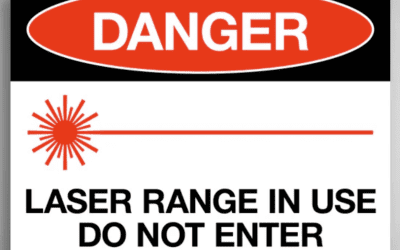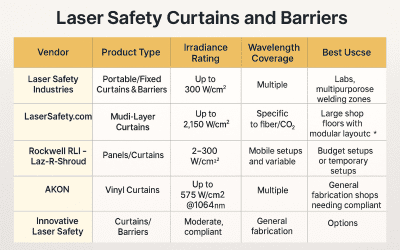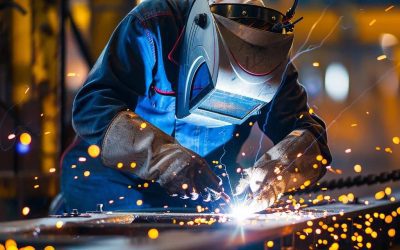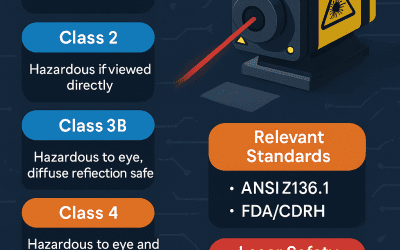Roles and Responsibilities in Laser Safety
Who’s Responsible for Laser Safety? Roles, Training, and Compliance Explained
In any environment where lasers are in use—whether industrial, clinical, or research-based—clear role definitions and strict adherence to laser safety protocols are essential. Understanding who is responsible for what ensures that personnel, equipment, and bystanders are protected, and that operations remain compliant with ANSI Z136 standards and OSHA requirements.
This article outlines the responsibilities of key personnel involved in laser operations, including the Laser Safety Officer (LSO), Laser Operators/Technicians, Authorized Personnel, and Spectators. Each role plays a distinct part in supporting a culture of safety and minimizing risk. For small and mid-sized organizations in particular, where teams may wear multiple hats, clearly defined roles and documented responsibilities are critical for consistent compliance and effective safety audits.
We’ll also examine required competencies, recommended training, and procedural oversight strategies that form the backbone of a compliant laser safety program. Whether you’re building a safety structure from scratch or refining an existing one, this guide provides actionable insights aligned with best practices and regulatory standards.
Key Takeaways
-
Laser Safety Officers (LSOs) oversee the laser safety program, conduct hazard evaluations, and enforce compliance with ANSI and OSHA standards.
-
Laser Operators/Technicians are responsible for equipment operation and routine maintenance, and must be trained in safe handling procedures.
-
Authorized Personnel are trained for specific tasks under supervision and may access laser-controlled areas under defined conditions.
-
Spectators must stay outside the Laser Controlled Area and follow all posted safety instructions and access restrictions.
-
Clear role definitions and active communication are fundamental to maintaining a safe, compliant laser environment.
Laser Safety Officer (LSO)
The Laser Safety Officer (LSO) holds primary responsibility for establishing, implementing, and enforcing the laser safety program within an organization. This role is mandated by ANSI Z136.1 for any facility operating Class 3B or Class 4 lasers, and is critical for ensuring that all laser use remains within safe, compliant boundaries.
The LSO is responsible for performing and documenting laser hazard evaluations, developing written safety protocols, and ensuring alignment with ANSI Z136, OSHA requirements. As technology evolves—such as the increasing use of fiber lasers, infrared systems, and automated CNC platforms—the LSO must regularly review and revise policies to reflect current hazards.
Key duties include:
-
Conducting routine audits of control measures (e.g., interlocks, barriers, warning systems)
-
Managing initial and refresher laser safety training
-
Reviewing incident and near-miss reports to identify trends and implement corrective actions
-
Maintaining up-to-date documentation including SOPs, PPE requirements, and NHZ boundaries
-
Collaborating with engineering and operations teams to integrate laser equipment into safe workflows
In addition, the LSO oversees compliance documentation and may serve as the point of contact during third-party inspections or certification reviews. Accurate records of hazard analyses, training logs, and protective equipment specifications are essential for proving compliance and maintaining a defensible safety posture.
By conducting regular inspections, tracking performance metrics, and guiding corrective actions, the LSO plays a pivotal role in safeguarding both personnel and high-value equipment—ensuring laser systems are operated responsibly and within regulatory limits.
Laser Operators / Technicians
Laser Operators and Technicians are the front line of laser system safety and performance. These personnel are directly responsible for the setup, operation, and maintenance of laser equipment across a wide range of applications—including cutting, engraving, marking, and fabrication.
Operators must be formally trained and authorized to work with Class 3B and Class 4 laser systems. Their duties include verifying that operational procedures, alignment protocols, and output settings adhere to the facility’s laser safety program and ANSI Z136 standards.
Typical responsibilities include:
-
Daily alignment and calibration of laser systems
-
Routine maintenance of optics, beam delivery components, and control interfaces
-
Monitoring beam pathways for obstructions, reflections, or misalignment
-
Adjusting output power settings as specified in approved procedures
Operators must also ensure that laser-controlled areas are secure, and that PPE, beam barriers, and interlocks are functional before activation. Real-time troubleshooting is another core function—operators must be able to identify and respond to issues that could result in overexposure, equipment damage, or safety breaches.
Documentation is a critical part of the role. Operators are expected to maintain accurate logs of maintenance activity, calibrations, and system adjustments, creating a traceable audit trail that supports both quality control and regulatory compliance.
Operators and technicians work closely with the Laser Safety Officer (LSO) to implement new safety protocols, integrate emerging laser technologies, and support inspections or audits. Their attention to detail and procedural consistency is key to minimizing exposure risks and ensuring safe operation of high-powered laser systems.
Authorized Personnel
Authorized Personnel are individuals who have been formally trained and certified to access laser-controlled areas (LCAs) and interact with laser systems under defined operational procedures. Access to these zones is contingent on the completion of site-specific training and a verified understanding of laser hazards as outlined in ANSI Z136.1 and organizational protocols.
This group typically includes maintenance staff, researchers, engineers, and service contractors who need to enter active laser environments for tasks such as equipment calibration, diagnostics, or supervised testing. Their access is regulated by the Laser Safety Officer (LSO) and managed via access control systems—such as badging, keypad entry, or biometric scans—to ensure only qualified individuals can engage with or be near energized systems.
Training for Authorized Personnel includes:
-
Use of PPE, including eyewear rated for the correct optical density (OD)
-
Electrical safety awareness for systems with high-voltage components
-
Operation and control of interlock systems and emergency shutoff devices
-
Familiarity with laser classifications, Nominal Hazard Zones (NHZs), and hazard signage
They must also understand and comply with emergency procedures, including how to respond to accidental exposure, equipment malfunctions, or control failures. Periodic refresher training and compliance briefings are required to maintain authorization, especially as technology evolves or system modifications are introduced.
Authorized Personnel are expected to stay current on both regulatory updates and system-specific changes that could affect operational safety.
By following documented SOPs, participating in routine audits, and maintaining clear communication with the LSO, Authorized Personnel help enforce a culture of proactive safety and operational readiness around high-powered laser equipment.
Spectators
Spectators are individuals who are present in a laser facility but are not actively involved in operating, maintaining, or servicing laser equipment. This group may include visiting personnel, clients, auditors, or new hires engaged in observational training. While their role is passive, their risk of inadvertent exposure to hazardous radiation requires that strict safety protocols be in place.
Spectators are only permitted in designated observation areas within or near Laser Controlled Areas (LCAs). These zones must be clearly marked with physical barriers, ANSI-compliant warning signs, and access control systems that delineate where safe observation is permitted. These controls prevent accidental proximity to open beams, scatter sources, or reflective surfaces.
Before entering any area where lasers are in use, spectators must:
-
Receive a pre-entry safety briefing covering the nature of potential beam and non-beam hazards
-
Be advised of required PPE, including laser safety eyewear if warranted
-
Understand safe distances from the beam path and how to avoid reflective surfaces
-
Be familiar with emergency evacuation routes and alarm protocols
In most cases, spectators should be escorted by Authorized Personnel or the Laser Safety Officer (LSO) during their visit. This ensures that real-time supervision is provided and that any changes to system status or hazard levels are promptly communicated.
Some facilities enhance observation safety using remote viewing systems, such as CCTV or live monitoring displays, to allow for effective demonstration or inspection without physical proximity to the laser system. This approach not only improves safety but also supports a positive audit posture by demonstrating the facility’s commitment to visitor protection and procedural compliance.
Conclusion
Establishing clear roles and responsibilities is foundational to any effective laser safety program. Whether you’re operating Class 3B systems in a fabrication shop or managing Class 4 lasers in a clinical or research setting, success depends on a well-defined organizational structure, consistent training, and strict adherence to ANSI Z136 standards.
The Laser Safety Officer (LSO) serves as the central authority for hazard evaluation, compliance, and control implementation. Laser Operators and Technicians bring safety protocols to life through proper system use and maintenance. Authorized Personnel are trained to perform specific tasks within defined limits, while Spectators must be protected through controlled access and supervised observation.
By aligning each role with its responsibilities, your organization builds a culture of accountability and safety awareness—one that protects people, ensures regulatory compliance, and supports uninterrupted operations.
Laser safety isn’t just a checkbox. It’s a system built on knowledge, discipline, and vigilance—and it starts with knowing who’s responsible for what.
Frequently Asked Questions
Q: What are the primary responsibilities of a Laser Safety Officer (LSO)?
A: The LSO is responsible for developing and enforcing the laser safety program, conducting hazard evaluations, leading training initiatives, maintaining safety documentation, and ensuring compliance with ANSI Z136.1, OSHA regulations, and applicable local codes.
Q: How do Laser Operators help maintain a safe working environment?
A: Laser Operators are trained to conduct daily system checks, calibrations, and preventive maintenance. They implement lockout/tagout (LOTO) procedures, monitor beam alignment and output, and ensure all PPE and control measures are in place before activation.
Q: Who qualifies as Authorized Personnel in a laser facility?
A: Authorized Personnel are individuals who have completed site-specific laser safety training and have been granted controlled access to Laser Controlled Areas. Their responsibilities are limited to defined tasks under the supervision of the LSO or other trained personnel.
Q: What safety protocols must Spectators follow in laser environments?
A: Spectators must remain in clearly marked safe zones, follow pre-entry safety briefings, use laser safety eyewear if required, and stay under real-time supervision while in or near areas where active laser systems are operating.
Q: How are laser safety procedures reviewed and updated within an organization?
A: Laser safety protocols are updated through routine audits, incident reviews, regulatory updates, and refresher training. The LSO is responsible for ensuring the program reflects current standards set by ANSI, OSHA, and any applicable certifying bodies.




